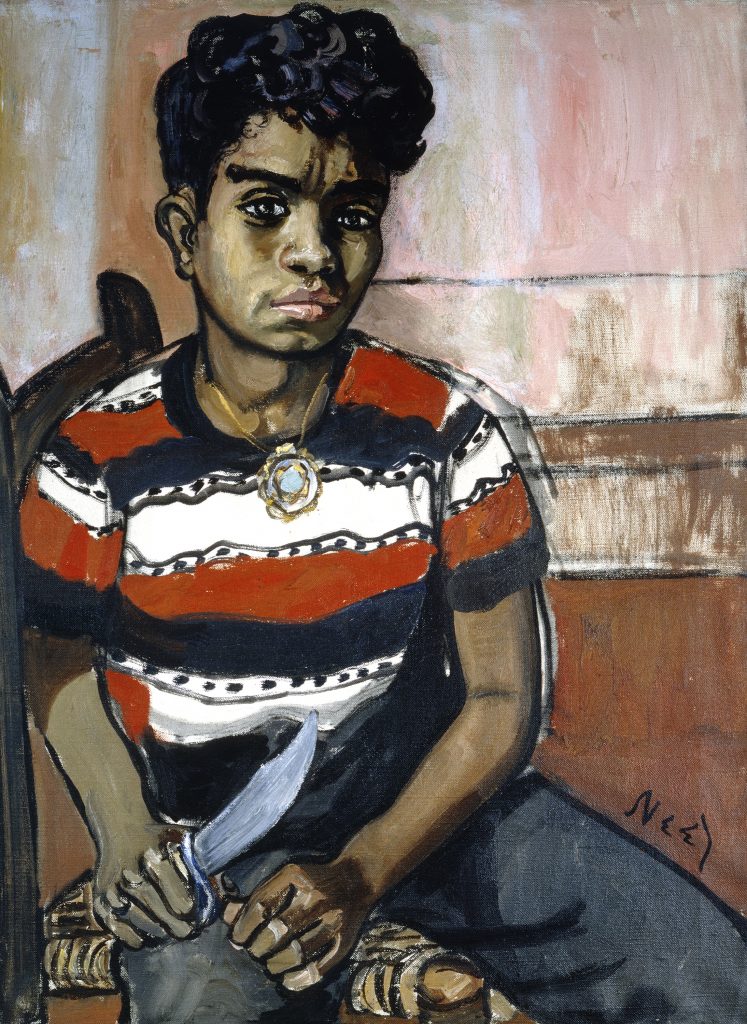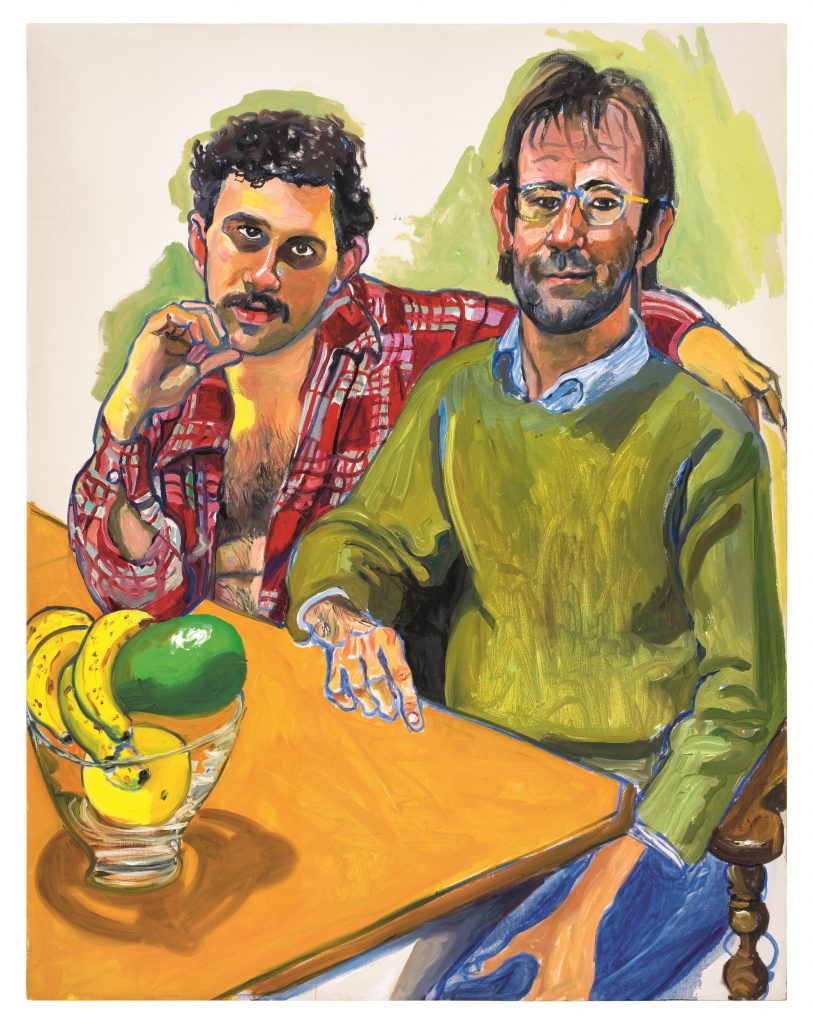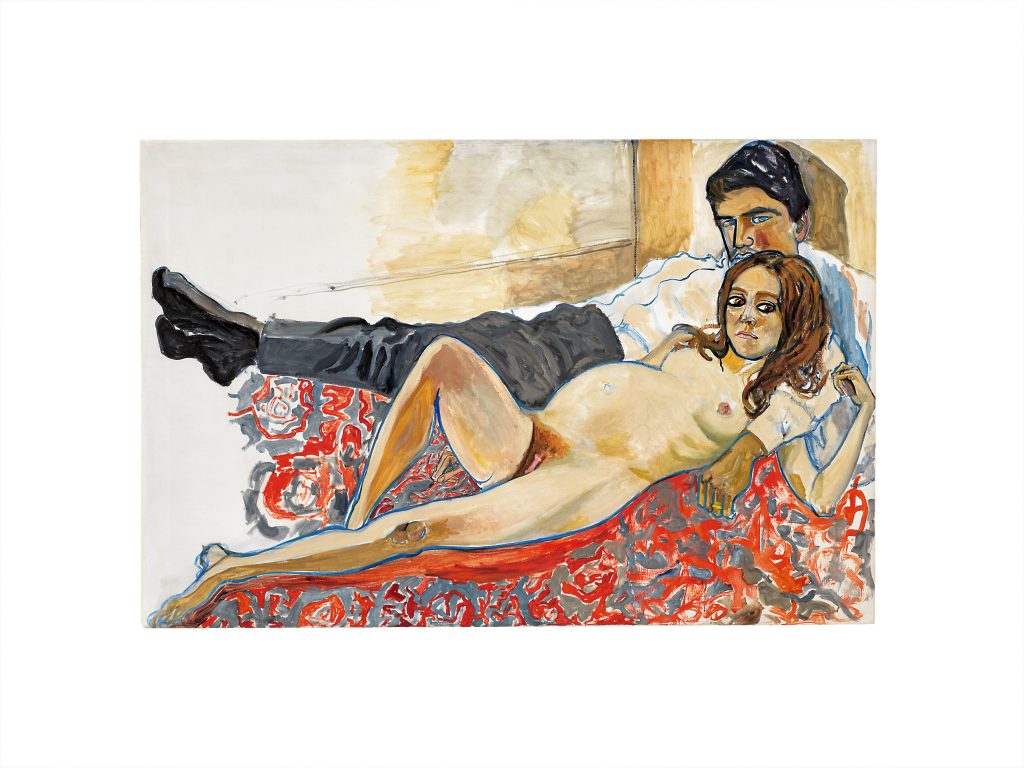Art & Exhibitions
‘Her Authenticity Is an Inspiration’: Why Alice Neel’s Soulful Portraits Have Found New Resonance With Artists and Audiences Today
The Barbican is showing Neel’s largest U.K. retrospective to date.

The Barbican is showing Neel’s largest U.K. retrospective to date.

Precious Adesina

In Georgie Arce, No.2 (1955), a painting by the Pennsylvania-born artist Alice Neel, a young Puerto Rican boy sits on a dining chair wearing a striped shirt and a large medallion. He holds a toy knife and, with furrowed brows, returns the viewer’s gaze. Neel painted and drew her neighbor, Georgie, starting from around ten years old, many times throughout the 1950s, inadvertently documenting his growth from a child to a teenager. Neel and Georgie both lived in Spanish Harlem, a heavily multicultural part of New York, where the artist resided from 1938 to 1962.
“For me, people come first,” journalist Mike Gold quotes Neel saying in 1950 in The Daily Workers, a newspaper published by the Communist Party USA. After a chance encounter, Georgie and Neel became friends for around three decades until Georgie was imprisoned for a double murder in 1974. “I have tried to assert the dignity and eternal importance of the human being in my portraits,” Neel added. Her painting of Georgie is on view in “Alice Neel: Hot Off the Griddle,” the most extensive U.K. retrospective of Neel’s work to date, at the Barbican Centre in London until May 21.
Neel–who died almost four decades ago at 84 years old—was relatively unknown for most of her life, but the vulnerability of her portrayals has made the artist into a household name across the globe today. There have been multiple major exhibitions on the artist’s work over the last few years, including at the Metropolitan Museum of Art in New York in 2021 and last year at the Centre Pompidou in Paris, the Guggenheim in Bilbao and the de Young Museum in San Francisco. She has also inspired many prominent artists alive today, including Amy Sherald, Wangari Mathenge, and Chantal Joffe. “Neel captures the soul of her subjects,” Sherald said. “Her authenticity is an inspiration.”
Even with Georgie’s determined stare, tight posture, and the way he firmly wields his ‘weapon,’ there is a tenderness to Neel’s portrait. “It feels like we see a boy who’s yearning to be a young man but who still cowers under his own childhood as well,” Eleanor Nairne, curator of the Barbican show, said. “You see that in many of Neel’s adult portraits, too,” Nairne added. “That sense of how we as people are often reaching for something but also intimidated by that thing we are reaching for.”

Alice Neel, Geoffrey Hendricks and Brian (1978). ©The Estate of Alice Neel. Courtesy The Estate of Alice Neel.
According to Emma Baker, head of contemporary evening sales at Sotheby’s, part of what has also enticed contemporary viewers and buyers to Neel’s paintings is the artist’s social consciousness, and how her portraits anticipated many issues that have only in recent years come to the forefront of mainstream conversations. It has been widely reported that Georgie’s incarceration was a result of the chaos, violence and underfunded system he grew up with. “She was very much attuned to what was going on socially and politically and translating that through the subjects that she chose to depict,” Baker said.
For some, Neel’s depictions of the boy can be seen as a sense of foreboding, from the cheerful little character seen standing with his leg pressed up against the chair in a painting from 1953 to the more pensive personality that comes later. But, for others, like the rest of Neel’s oeuvre, each portrait of Georgie shows the multidimensionality of being human—Neel provides an honest illustration of his innocence, hopes, struggles, and joy, all perfectly entwined. “Part of what I find so compelling about looking at her work is how they don’t calcify into a single fixed image of a person,” Nairne said. “They have some sense of multiplicity in them because we are all, as people, multiple.”
Beyond Georgie, Neel’s extensive oeuvre not only depicts her friends and family but also marginalized people in New York, including nude pregnant women, who often weren’t found in dignified portraits, part of which has made her into a feminist icon today, though she may not have agreed with being pigeonholed as one. “She painted everyone: people of colour, the elderly, the poor, and gay and transgender people, and persevered through a time when figuration was renounced,” artist Amy Sherald said.

Alice Neel, Pregnant Julie and Algis (1967). ©The Estate of Alice Neel . Courtesy The Estate of Alice Neel.
Neel actively went against the grain of her time, which included disregarding Abstract Expressionism during the 1940s and ‘50s, Pop art during the 1960s, and Minimalism. Consequently, she struggled financially. From 1933, she received a small sum to produce pieces as part of the Public Works of Art Project (replaced by the Works Project Administration created by President Franklin D. Roosevelt in 1934), a program that employed artists to create works for public buildings and parks during the Great Depression. “It wasn’t a very big income, but it gave me enough to live and paint on,” Neel told the American art historian Cindy Nemser for the book Art Talk: conversations with 12 women artists, published in 1975. In 1943 when the payments ended, she immediately went on welfare until the 1950s, bringing up her children on a tight budget. They managed to live a “nice lifestyle” nonetheless, Neel’s son Hartley told a journalist after her death. “The only reason it was sensitive is that something is embarrassing about being on welfare,” he said. “It’s a certain stigma associated to that.”
Over the last two decades, “we’ve seen a real return to figuration for many artists,” Nairne said. Who has been and is being represented, and how, has also been a topic brought to the fore, especially with movements such as #MeToo and Black Lives Matter. “It’s interesting to look back to who some of those historical figures were during the 20th century who became important role models or influences on those artists.”
Sticking with these portraits for so long shows that Neel knew that one day society would value these sorts of paintings and understand the power that portraiture holds to spark conversations around social issues. “She’s a testament to the idea of perseverance, Sotheby’s Baker said, “and to having faith and commitment and belief in what you’re doing.”
“Alice Neel: Hot off the Griddle” is on view through May 21 at Barbican Art Gallery. The accompanying book Alice Neel: Hot Off The Griddle, edited by Eleanor Nairne, with essays by Eleanor Nairne, Hilton Als and poetry by Daisy Lafarge, is published by Prestel, March 2023.